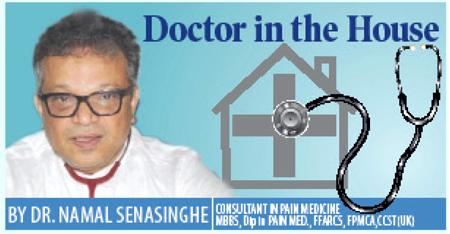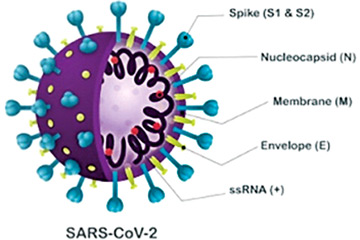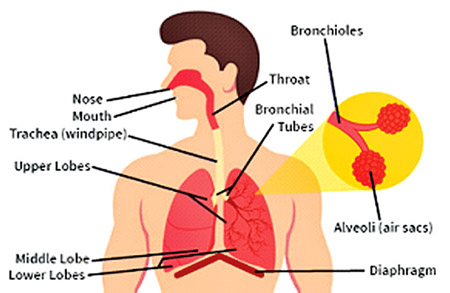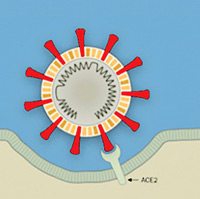
SAR-CoV-2 is the virus responsible for the global Covid-19 (Coronavirus Disease 2019) pandemic, first identified in Wuhan, China in 2019 [1]. It has been colloquially referred to as Coronavirus, deriving from the Latin Corona – meaning crown. This is demonstrated by the virus’ crown like ring of Spike Proteins (S proteins) which encapsulate it [2] – see figure 1.
 Figure 1. Image Credit: Frontiersin
|
The life cycle of the viruscan can be outlined in the following stages:
1) Transmission
· SARS-CoV-2 molecules are carried in liquid droplets present in our respiratory tract. These droplets are spread from one human to another via coughing, sneezing and even speaking. This spread can occur through direct human contact, close contact or contaminated surfaces [3].
· Understanding transmission of the virus allows us to create means to mitigate the spread of the virus e.g. Mask wearing, appropriate social distancing and decontamination of surfaces.
2) Contact with healthy cells
· Once the droplets containing SARS-CoV-2 enters into a new host (i.e. another human), the virus attaches to healthy (seen in green in Figure 2) using its Spike Proteins (seen in red in Figure 2) like a key on a lock[4].
|
Figure 2 Image credit: New York Times |
3) Viral Replication
· Once attached to a host cell, SARS-CoV-2 releases genetic material called RNA into our own healthy cells. Special proteins called Ribosomes within our cells are hijacked, using the virus’genetic material to create new viral components. These viral components merge with outer layers of host cells, creating new Coronavirus molecules. This process continues as the virus replicates and spreads within the body [5].
4) Disease Progression
· To understand how the virus affects the body, it is useful to know the structure and mechanism of the lungs (Figure 3). Oxygen travels into the nose/mouth then to the Trachea (windpipe) branching into Bronchi then Bronchioles finally Alveoli. The Alveoli are lined with small blood vessels called Capillaries which absorb the oxygen into the blood sending it to the rest of the body. Carbon dioxide is drawn into the Alveoli from capillaries and is expelled from the body in the opposite direction [5].
· As the Coronavirus replicates using our own body’s healthy cells, this causes damage to the structures from which these cells originate. The virus overwhelms the immune system, causing inflammation in the lining of respiratory tract [6].
· Higher up in the respiratory tract, Covid-19 may cause sneezing, changes in smell/tasteor sore throat [1].
· As inflammation progresses lower down the respiratory tract this can lead to coughing, fevers, shortness of breath or chest pain. Alveoli can become filled with fluid, making it difficult to supply oxygen to the blood. This lack of oxygen can then affect other organs in the body. Bacteria can take advantage of the environment in the lungs leading to a bacterial chest infection [1].
This cycle continues and returns back to stage 1, transmission to another individual. Some people may be Asymptomatic (have no symptoms) but still spread the virus. Knowing how SARS-CoV-2operates can help implement measures that can be taken to prevent the spread of Covid-19 and how vaccines work against it.
Dr. Bhanuka Senasinghe MBChB (Hons), MA Clinical ResearchPhysician – Therapy Areas: Covid-19,
Influenza, RSV London, United Kingdom
 Figure 3. Image Credit: Belluscura
|
References
1. Alimohamadi Y, Sepandi M, Taghdir M, Hosamirudsari H. Determine the most common clinical symptoms in Covid-19 patients: a systematic review and meta-analysis. J Prev Med Hyg. 2020;61(3):E304–12.
2. Chorba T. The concept of the crown and its potential role in the downfall of Coronavirus. Emerg Infect Dis. 2020;26(9):2302–5.
3. Coronavirus disease (Covid-19): How is it transmitted? [Internet]. Who.int. [cited 2021 Sep 8]. Available from: https://www.who.int/news-room/q-a-detail/coronavirus-disease-covid-19-ho...
4. Velavan TP, Meyer CG. The Covid-19 epidemic. Trop Med Int Health. 2020;25(3):278–80.
5. How the lungs work [Internet]. Nih.gov. [cited 2021 Sep 8]. Available from: https://www.nhlbi.nih.gov/health-topics/how-lungs-work
6. Nakagawa K, Lokugamage KG, Makino S. Viral and cellular mRNA translation in Coronavirus-infected cells. Adv Virus Res. 2016;96:165–92.

